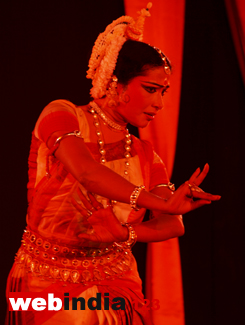|
|

|
|

| INTRODUCTION TECHNIQUE MOVEMENTS PATTERN HASTAS REPERTOIRE DANCERS |

Odissi dance uses a variety of hand gestures both in its technique of pure dance as also abhinaya.The ardha pataka with two fingers extended and two infolded is called the danda. The kataka i.e. where the index finger is held over the thumb and other fingers are extended is called the ankush.
The smallest unit of movement in Odissi is the Khandi. The khandi is the beginning of movement form either the standing position in the samapada or the tribhanga or the chauka. The dancer begins her practice by executing foot contacts right and left and through the manipulation of equally distributed weight as also unequal weight. These very small clusters of movements invariably begin with a static position and return back to the static position. Normally, movements are executed first to the right and then to the left. The dancer is taught to hold one half of her body static and to move the other half either through the leg extension or leg contractions or through crossing front or back. Later each movement is practiced by relating to rhythm effort, strong or soft. They are first executed in place always bearing in mind the central axis (the vertical median) and distribution of weight. Next the space is explored. The khandis are primary movements beginning with categories, place, exploring space in all directions. Some are based only on the samapada and tribhanga. Others combine samapada, tribhanga and the chauka. All are executed to the accompaniment of mnemonics called Ukkatta. Later they are executed in a given metrical cycle of four, five, six, seven, eight or nine beats. Further refinement is brought into it by dividing say an eight beat cycle into different segments. There can be 4,2 and 2; 3,3 and 2; or 3,4 and 1. Each time a new movement unit emerges.
Arasas is the next unit comprising khandis comparable to the formation of simple sentences through a combination of words. Beginning with the smallest unit, combinations are made of words and phrases and then sentences, all contained within the periphery or parameters of the metrical cycle.
The nritta technique of Orissa rests for its strength on a complete mastery over the full gamut of the khandis and arasas which can then be used in sequence of the dance called the belis and the palis. The belis are longer sections of nritta and the palis are the finale sequences also in triplets as in the case of the other dance styles. The dancer has to master various aspects of the nritta technique comprising the static positions, the sculptural poses, the manner of covering space and has known how to manipulate the metrical cycle through the articulation of the neck, torso and the movement of the lower limbs and to cover space in different directions and to move along straight lines, diagonals, figures of eight and spirals and to shift weight and play with levels. Later she is taught to control energy and to play with levels. Later she is taught to control energy and to play with movement which flows out of body and at other times flows into the body. The juxtaposition of strong and soft movements expanding and contracting, enlarging and dwarfing is characteristic.
Odissi dance commences with an invocation to gods and salutations to the Mother Earth, the elephant headed god Ganesha or Vighneshwara, the Remover of the obstacles and the teacher to the accompaniment of rhythmic vocal syllables (Bani or Ukuttas) blended into drum beats set to tal known as Ghali. The chant of the musicians in a particular raga, the rhythmic beat on the drum and the lilting and measured feet movements of the danseuse are so harmonized that they produce a fine balance between the dance and the dancer and the spectators are ushered into a fascinating world of mime, music and motifs reflecting sculpture stances. Odissi is based on the Karanas, the basic alphabets of the language of hands and other limbs called Sthanaks.
The dancer interprets the rhythmic syllables of the conductor with her naynabhinaya, gestures and rhythmic movements of the feet at a quicker speed. The prelude ends with the recitation of a shloka in Sanskrit or Orissi and its fine interpretation by the dancer reflecting a delicate balance between Nritta, Nritya and Natya. Then follows Pallavi, corresponding to Bharata Natyam's Jatiswaram. Pallavi comprises a sequence of pure dance pieces set to a dulcet singing of the dancer and its interpretation by facial and eye expression. Pallavi is highly lyrical which familiarizes us with mood of the dance. Being so poetical and pleasing, there are more than two numbers set to a raga and tal. Usually these are from the Gitagovinda, underlining the passionate love of Krishna for the cowherds Radha, the symbolical representation of the human soul, ever yeaning to be united with the supreme soul. It is very evocative item full of fine sculpturesque stances, scintillating footwork, a variety a dance patterns demanding a great command and technique on the part of the dancer, and finally leading to the climax of Moksha. Moksha corresponds to Bharata Natyam's Tillana. Moksha literally means salvation, liberation, release or deliverance. It is a state of inexpressible equipoise, harmony, happiness and fulfillment when all duality ceases and a perfect identification dawns on the aspirant with the Brahman or Ishvara. This is the highest and the purest state when one becomes pure attention and concentration. Here the dance and the dancer become one culminating into an all inclusive awareness, a fathomless, deep consciousness where all thoughts are dissolved and fused into perfect harmony and equilibrium.